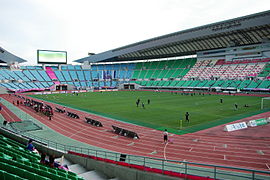Yanmar Stadium Nagai
 | |
 | |
| Former names | Osaka Nagai Stadium (1964–2014) |
|---|---|
| Location | Nagai Park, Higashisumiyoshi-ku, Osaka, Japan |
| Coordinates | 34°36′50.83″N 135°31′6.42″E / 34.6141194°N 135.5184500°ECoordinates: 34°36′50.83″N 135°31′6.42″E / 34.6141194°N 135.5184500°E |
| Public transit | R Hanwa Line at Nagai |
| Owner | Osaka City |
| Capacity | 47,816 |
| Field size | 105 x 68 m |
| Surface | Grass (107 m x 71 m) |
| Scoreboard | Yes |
| Construction | |
| Opened | 1964 |
| Renovated | 2007 |
| Expanded | 1996 |
| Tenants | |
| Cerezo Osaka (1996–present) | |
| Website | |
| About Nagai Stadium (in Japanese) | |
Yanmar Stadium Nagai (ヤンマースタジアム長居) is an athletic stadium in Osaka, Japan. It is the home ground of J. League club Cerezo Osaka. The stadium has a seating capacity of 47,000.
History[]
When Nagai Stadium initially opened in 1964, its capacity was 23,000, and its opening event was a soccer match during the 1964 Summer Olympics. The stadium's seating capacity was expanded to 50,000 in 1996 for the 52nd National Sports Festival of Japan in 1997.
The stadium hosted three matches in the 2002 FIFA World Cup.
| Date | Team #1 | Res. | Team #2 | Round |
|---|---|---|---|---|
| 12 June 2002 | 0–0 | Group F | ||
| 14 June 2002 | 0–2 | Group H | ||
| 22 June 2002 | 0–1 (asdet) | Quarter-finals |
Nagai Stadium has been used many times for athletic competitions; it played host to the Athletics at the 2001 East Asian Games and the 2007 World Championships in Athletics. It is also the venue for the annual Osaka Grand Prix athletics meeting which took place every May from 1996 to 2010, and again since 2018. In addition, the stadium is the starting and finishing point for the Osaka International Ladies Marathon, held annually in late January-early February.[1]
Access[]
Rail transit[]
- It takes 3 minutes on foot from Tsurugaoka Station on JR-West Hanwa Line.
- It takes 5 minutes on foot from Nagai Station on JR-West Hanwa Line and Osaka Municipal Subway Midōsuji Line.
- It takes 20 minutes on foot from Harinakano Station on Kintetsu Minami Osaka Line.
Osaka City Bus[]
- Subway Nagai
-
- Route 4: Subway Suminoekoen – Subway Nagai – Deto Bus Terminal
- Route 24: Sumiyoshi Shako-mae – Subway Nagai – Minami-Nagai
- Route 40: Sumiyoshi Shako-mae – Subway Nagai – Deto Bus Terminal
- Nagaikoen-kitaguchi
-
- Route 54A: Sumiyoshi Shako-mae → Subway Abiko → Takaai Danchi-mae → Nagaikoen-kitaguchi → Subway Nishitanabe → Furitsu Sogo-iryo-center (General Medical Center) → Sumiyoshi Shako-mae
- Route 54B: Sumiyoshi Shako-mae → Furitsu Sogo-iryo-center (General Medical Center) → Subway Nishitanabe → Nagaikoen-kitaguchi → Takaai Danchi-mae → Subway Abiko → Sumiyoshi Shako-mae
See also[]
- Nagai Aid Stadium
- Nagai Ball Gall Field
References[]
- FIFA.com 1964 Summer Olympics JPN-YUG results from the stadium. - accessed 14 August 2010.
- ^ Nakamura, Ken (2001-05-25). Day One of the East Asian Games. IAAF. Retrieved on 2010-02-28.
External links[]
![]() Media related to Nagai Stadium at Wikimedia Commons
Media related to Nagai Stadium at Wikimedia Commons
- Official site (in Japanese)
- Athletics (track and field) venues in Japan
- 2002 FIFA World Cup stadiums in Japan
- Football venues in Japan
- Rugby union stadiums in Japan
- Sports venues in Osaka
- 2007 World Championships in Athletics
- College football venues
- Venues of the 1964 Summer Olympics
- Olympic football venues
- Venues of the 2020 Summer Olympics
- Cerezo Osaka
- American football venues in Japan
- 1964 establishments in Japan
- Sports venues completed in 1964

